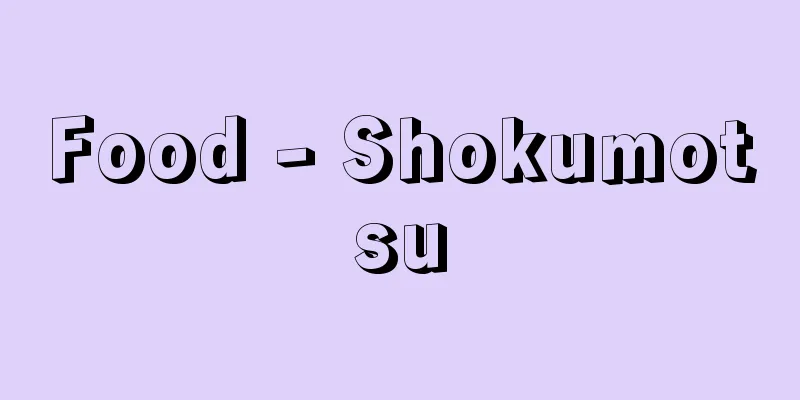Food - Shokumotsu

|
It means food and is almost synonymous with foodstuffs and provisions, but it often refers to things that have been cooked or processed and can be eaten immediately. [Hideo Aoki] WesternThe ancient Egyptians ate mainly mullet, catfish, and perch (a Nile fish with sharp fins), either dried or salted, as well as bread and cakes made from flours of barley, spelt, and, later, wheat. Animals were killed and hung until ripe for eating. In the Orient, Babylonia and Assyria ate bread made from barley. Yeast was not yet in use. They ate onions, lentils, broad beans, peas, cucumbers, cabbage, and lettuce. They used dates as a sweetener. They ate fruits such as apples, figs, quince, and pomegranates. They ate a lot of fish, but only beef, mutton, and goat meat on special occasions. They also used yogurt and cheese. In ancient Greece and Rome, people mainly ate baked or steamed foods. In Greece, the standard diet consisted of a small amount of bread, wheat or barley porridge, vegetables, meat, and condiments. Meat was only eaten by the nobility, and the general public was mainly vegetarian. Bread was expensive and difficult to obtain. They ate tuna, mackerel, icefish, mullet, and fruit. Meat was wild or domesticated birds, or pork. Beef was only eaten on religious occasions. In the 5th century BC, sophisticated chefs came to Athens from Sicily, bringing with them dishes such as baked tuna. In Rome, there were bakers from around 200 BC, and they also knew about the fermentation process. Bread was flavored with poppy seeds, aniseed, celery, fennel, sunflower seeds, sesame seeds, and small grapes. Eggs were also from ducks, pigeons, and mantis shrimp. Sometimes they ate wild goose eggs. In the Middle Ages, people ate fish, eggs, and oatmeal. They ate no meat except from game, domestic birds, and pigeons. Orchards were planted with apples, pears, plums, rowan, hawthorn, bay, chestnuts, figs, quince, peaches, hazel, almonds, and mulberries. Other edible plants included onions, leeks, celery, coriander, dill, poppy, and carrots. In the early Middle Ages, lamb was rarely eaten because wool was a valuable commodity. Beef was rarely eaten because cattle were used as draft animals. In 1180, there was a pepper merchants' guild in London. Pepper was so expensive at the time that it was even mentioned in wills. Sugarcane, a sweetener, also appeared around the 13th and 14th centuries. In the 16th century, the French ate very little bread and fruit, but started to eat a lot of meat, and also pies and pates. Germain Lippomano, the Venetian ambassador to France, reported that "every village and even town had a butcher or pastry shop." Castrated chickens, eels, and partridges were cheap to buy. In the 17th century, potatoes were introduced to Spain from the Americas. Around 1616 in France, potatoes were still a luxury item and only appeared on the king's table, but by 1800 they had become established and widespread. Corn and rice were also eaten. Garlic was fried in butter and eaten. There were dishes such as garlic fried with red turnips, and beef and lamb stewed with vegetables. In the 19th century, stew pots appeared. Also, there were many ways to prepare salads. Along with that, dressings were invented. As restaurants developed, cooking methods developed, and food became more abundant. [Hideo Aoki] AsiaThe Indus civilization built city-states, cultivated barley and wheat, and raised livestock before the Aryan invasion of India (around 1500 BCE). There were several routes for the spread of wheat to eastern Asia, and the main route for wheat that reached China was via Tibet, where barley was introduced in the early days and wheat later. As in China, barley was the main crop in India. The only traditional flour milling method in India was a hand-cranked stone mill, and it was only from the 18th century that flour became the daily food of the general public. Today, the western part of India is made of wheat, and unleavened chapati, which is made mainly from wheat, is the staple food. Strict religious discipline is widespread, and many Hindus, who make up the majority, follow a vegetarian diet. Cows are considered sacred, so eating beef is strictly prohibited. However, today, the upper classes are gradually showing a tendency to eat beef. Just like in Southeast Asia, a wide variety of spices are essential to the diet. The representative cuisine of the southern part of the country is vegetarian cuisine. The basic ingredients are rice, dal (dried beans), milk, coconut, and vegetables. Milk is an essential part of Indian cuisine, a delicacy and a source of protein. Rice is the staple food in the eastern part of the country as well as the southern part, and is eaten cooked. In Ceylon (Sri Lanka), there is a dish called "seegi." It is made by kneading non-glutinous rice flour with water, rolling it thinly, and baking it like chapati. It is a staple food of the people of Ceylon. In terms of meat, Hindus place the highest priority on goat, followed by sheep and chicken, while Muslims place the highest priority on sheep, followed by goat and chicken. The cooking methods of this culinary region are characterized by the use of curry and the use of ghee as the main fat. In the eastern part of the country, mustard oil is used, which adds a unique flavor. Coconut is used in the coastal areas. Waterwheel milling in China was popular around the Tang dynasty, so the shift from barley to wheat was quite early compared to India. In the Song dynasty, there was a remarkable improvement in dietary habits, and restaurants developed significantly. It was also during the Song dynasty that the basis of today's Chinese cuisine, which is mainly pork dishes, was established. It was also during the Song dynasty that people began to eat rice from central to southern China. In the 18th century, the Qing dynasty also became almost the same as today's diet. The Chinese staple food is rice in Jiangnan and wheat in northern China, which is a stark contrast, but it is dangerous to make such an extreme distinction. Today, rice cultivation has spread from northern China to the north, and in the northeast region, it is possible to grow rice as far as Jilin Province, and rice consumption has become widespread. In Jiangnan, the rice variety is mostly japonica, the same as in Japan, while further north, the long-grain rice variety called indica is the norm. Rice cooking methods include the yudori method, the yudorite method, the takiboshi method, and steaming. In terms of taste, simple steamed rice is the stickiest, followed by rice cooked using the takiboshi method. Rice cooked using the yudori method has a smooth texture. In China, northern China is the region where the yudori method is used, while central and southern China are the regions where the takiboshi method is used, including Taiwan. The yudori method is used on the Korean Peninsula. Another rice dish is porridge. It is rice porridge made from whole grains, but the Chinese have a much stronger preference for porridge than the Japanese, and in ordinary households, porridge is often eaten for breakfast. The most common forms of wheat consumption are mantou (buns) and udon (noodles), which are more common foods today than foxtail millet and millet. Farmers in northern China eat both udon and mantou, and when they go to work in the fields, they often carry a mantou or two and a bottle of water for their lunch. Mantou is a fermented steamed bread made by semi-fermenting whole wheat flour and steaming it. Udon is a hand-made stew, and is called "hoto" in Japan. Udon has spread mainly from China to Japan and Mongolia. The second type of wheat dish is one that is kneaded with water and steamed, and the most representative is uotou (whole wheat). Wheat is considered to be elegant, but millet, foxtail millet, corn, and sorghum are ranked in order of quality. Half of the dishes made with millet and other grains are considered to be porridge. In China, porridge is mainly in the form of grains, while in India and Africa, it is in the form of powdered porridge. In addition, cooking techniques are characterized by the use of soy sauce, the use of a lot of oils and fats, cooking over high heat, and the diversity and use of preserved foods. China, Japan, Korea, and Southeast Asian countries also have cultural traditions that notably do not use milk, and this overlaps with the rice-eating culture. It was not until the latter half of the Meiji period, and indeed into the 20th century, that rice consumption became widespread and commonplace across Japan. The annual rice consumption per person in Japan was 1 koku (150 kilograms) for only a short period of less than 40 years, from 1903 (Meiji 36) to 1940 (Showa 15). Rice was a staple food, but it was not eaten regularly for a long time. However, the Japanese diet continued for a long time as a combination of three items: rice, miso soup, and pickles. [Riki Otsuka] "The Origin of Cooking" by Sasuke Nakao (NHK Books)" ▽ "The Food Culture of the World" edited by Naomichi Ishige (1973, Domesu Publishing) ▽ "The Modern History of Food" by Tsutomu Otsuka (1979, Kyoikusha) ▽ "Food and History" by R. Tannahill, translated by Masatoshi Onomura (1980, Hyoronsha) [Reference] | | |Source: Shogakukan Encyclopedia Nipponica About Encyclopedia Nipponica Information | Legend |
|
食べ物の意で、食品、食料とほぼ同意語であるが、調理、加工してすぐ口に入れられるようにしたものをいう場合が多い。 [青木英夫] 西洋古代のエジプト人が食用にした魚は主としてボラ、ナマズ、パーチ(ナイル川にすむとがったひれをもつ魚)で、干してそのままか、さらに塩漬けにして食べた。また、大麦やスペルト小麦、そして時代が下ってからは小麦を挽(ひ)いた粉で焼いたパンやケーキも食べた。食物とする動物は、殺して食べごろまで吊(つ)るしておいた。 オリエント地方のバビロニアやアッシリアでは大麦でつくったパンを食べた。まだイーストは用いられなかった。タマネギ、レンズマメ、ソラマメ、エンドウ、キュウリ、キャベツ、レタスを食べた。甘味料としてはナツメヤシを用いた。リンゴ、イチジク、マルメロ、ザクロなどの果実を食べた。魚は多量に食べたが、牛肉、羊肉、ヤギ肉は特別の場合にのみ食べた。そのほかにヨーグルトやチーズも使った。 古代ギリシアやローマではおもに焼いたり蒸し焼きにしたものを食べた。ギリシアでは常食としては、少量のパンと小麦や大麦の粥(かゆ)、それに野菜、肉類、薬味があった。肉は貴族階級だけが用い、一般民は菜食中心であった。パンは高価で、手に入らなかった。マグロ、サバ、シラウオ、ボラ、果物を食べた。肉は野鳥や飼い鳥の肉、もしくは豚肉であった。牛肉は宗教的な行事のときに限られていた。紀元前5世紀にはシチリアから洗練された料理人が料理を伴ってアテネに入ってきた。たとえば焼いたマグロなどである。ローマでは、前200年ころから、製パン業者もあり、発酵作用についても知っていた。パンはケシの実、アニスの実、セロリ、ウイキョウ、ヒマワリの種、ゴマ、小粒のブドウなどで香りをつけた。また、卵はカモ、ハト、シャコの卵であった。ときには野生のガチョウの卵を食べた。 中世では魚や卵、オートミールを食べた。肉類は猟鳥獣や飼い鳥やハト以外は食べなかった。果樹園には、リンゴ、西洋ナシ、プラム、ナナカマド、西洋サンザシ(カリン)、ゲッケイジュ(月桂樹)、クリ、イチジク、マルメロ、モモ、ハシバミ、アーモンド、クワなどを植えた。また、タマネギ、ボロネギ、セロリ、コリアンダー(円形で香りのある果実)、イノンド(果実は香料や薬用にする)、ケシ、ニンジンなどが食用となった。中世初期には羊肉はほとんど食べなかった。羊毛が貴重であったためである。牛肉もめったに食べなかった。役牛として利用したからである。 1180年のロンドンには胡椒(こしょう)商人ギルドがあった。当時胡椒は、遺言書にも出ているくらい高価であった。甘味料のサトウキビも13世紀から14世紀ころに出現した。 16世紀になるとフランスでは、パンと果物はほとんど食べなかったが、肉を多く食べるようになり、またパイやパテを多く食べた。ベネチアの駐仏大使ジローム・リッポマーノは「あらゆる村、町にさえ焼き肉屋や練り菓子屋がある」と伝えている。去勢したニワトリやウナギ、ヤマウズラのローストが安く買えた。17世紀にはジャガイモがアメリカ大陸からスペインに伝わった。1616年ごろのフランスではジャガイモはまだぜいたく品であって国王の食卓にしか上らなかったが、1800年ころに定着・普及した。トウモロコシ、米なども食べた。ニンニクはバターで炒(いた)めて食べた。赤カブのニンニク炒めや牛肉、羊肉を野菜といっしょに煮込んだものがあった。 19世紀にはシチュー鍋(なべ)が現れた。またサラダの作り方も多くなった。それとともにドレッシングができた。レストランの発達とともに料理法も発達し、それによって食物は豊富になった。 [青木英夫] アジアインダス文明は、アーリア人のインド侵入(前1500ころ)以前に都市国家を築き、大麦、小麦を栽培し家畜を飼っていた。アジア東部への伝播(でんぱ)にはいくつかのルートがあり、中国へ到達した麦類はチベット経由が主ルートで、初期は大麦、のちに小麦が伝えられた。インドも中国と同じく大麦が主力であった。インドの在来製粉法は手回しの石臼(いしうす)だけで、大勢からみて一般民衆の日常食が粉食となったのは18世紀からである。いまのインドの西部は小麦食で、それを主原料とする無発酵のチャパティが主食である。宗教的戒律が厳しく行き渡り、大半を占めるヒンドゥー教徒は精進食をとる者が多い。牛を神聖としているので牛肉食は厳禁されている。だが今日では上流階級では、しだいに牛肉食になる傾向を示している。多種多量の香辛料が食事に欠かせないのは東南アジアと同じである。南部の代表的料理というと菜食主義のベジタリアン料理がある。基本は、米、ダール(乾燥豆)、牛乳、ココナッツ、それに野菜である。牛乳はインド食に不可欠のもので、御馳走(ごちそう)でありタンパク源となっている。南部とともに東部も、米を主食とし炊飯して食べている。セイロン島(スリランカ)には「シーギ」がある。粳米(うるちまい)の粉を水で練り、薄く伸ばしてチャパティのように焼いて食べる。セイロン島民の常食である。肉食については、ヒンドゥー教徒はヤギを上位とし、ヒツジ、ニワトリの順に、イスラム教徒はヒツジを上位とし、ヤギ、ニワトリの順に食べている。この料理圏ではカレーの使用と主要な油脂としてギーが用いられるのが料理法の特徴である。また東部ではからし油が用いられており、独特の風味を添えている。沿岸部ではココヤシが用いられている。 中国における水車製粉は唐代ころから盛んになっていたから、インドに比較すると相当早い時期に大麦から小麦に移行したことになる。宋(そう)代になると食生活の著しい向上がみられ、料理屋の発達が顕著となる。豚料理を主体とする今日の中国料理のもとができあがったのも宋代からである。華中から華南にかけて米食をするようになったのも宋代からである。清(しん)代も18世紀になると、ほとんど今日と同じ食生活の様相となってくる。中国人の主食は江南の米に対して華北の小麦が対照的であるが、あまり極端に分けるのは危険である。今日では米作は華北から北に伸長し、東北地区では吉林(きつりん)省あたりまで栽培が可能となり、米食が浸透している。品種は江南が日本と同じジャポニカとよばれる米が多く、それより北ではインディカとよばれる長粒のものが主となる。炊飯法には湯取(ゆど)り法、湯立て法、炊干(たきぼ)し法、蒸飯などがあげられる。食味からすると単純な蒸飯がいちばん粘り気が強く、炊干し法による飯が次に粘り気がある。湯取り法の飯はさらさらした飯となる。中国では華北が湯取り法の地域であるのに対し、華中と華南は炊干し法の地域で、台湾もこれに入る。朝鮮半島は湯取り法である。米料理にはほかに粥(かゆ)がある。米の粒粥であるが、中国人の粥に対する嗜好(しこう)は日本人よりはるかに強く、一般の家庭では朝食に粥を食べることが多い。 小麦の消費形態の代表はマントウ(饅頭)とうどん(麺(めん)条、面条)で、今日ではアワ、キビより普遍的な食物である。華北の農民たちはうどんとマントウをともども食べ、とくに畑仕事の弁当にはマントウの1、2個に水を携行する。マントウとは全粒製粉の粉を半発酵させ、蒸してつくった発酵蒸しパンである。うどんは手打ちの煮込みで、日本では「ほうとう」とよんでいる。うどんは中国を中心として日本とモンゴルに伝播している。小麦料理の第二は水で練り固めて蒸したもので、代表的なのはウオトウ(窩頭)である。小麦使用が上品であるが、ほかにキビ、アワ、トウモロコシ、コウリャンの順に品質が位置づけられている。キビ以下の雑穀の料理の半分は粥とされる。中国ではおもに粒粥の形態となるが、インド、アフリカは粉粥である点が対照的である。また、醤(しょう)の使用、油脂の使用が多いこと、強火で調理すること、保存食品の多様性とその活用などに調理技術の特徴がある。顕著に乳を利用しない文化伝承をもっているのも、中国をはじめ、日本、朝鮮、東南アジア諸国であるが、これは米飯文化圏と重複する。 日本において米食が浸透し、全国的に一般化するのは明治期の後半になってからであり、実に20世紀に入ってからのことである。日本人の1人年間、米の消費量が1石(150キログラム)となるのは1903年(明治36)以降、40年(昭和15)までのわずか40年たらずの短期間にすぎない。米は主食であったが常食とは長い間なりえなかった。しかし、日本食は米飯を中心とするみそ汁と漬物の三つの組合せパターンとして長く続いてきた。 [大塚 力] 『中尾佐助著『料理の起源』(NHKブックス)』▽『石毛直道編『世界の食事文化』(1973・ドメス出版)』▽『大塚力著『「食」の近代史』(1979・教育社)』▽『R・タナヒル著、小野村正敏訳『食物と歴史』(1980・評論社)』 [参照項目] | | |出典 小学館 日本大百科全書(ニッポニカ)日本大百科全書(ニッポニカ)について 情報 | 凡例 |
>>: Hair Transplant - Shokumoujutsu
Recommend
Xi-xiang-ji (English: Xi-xiang-ji)
A Chinese play from the Yuan Dynasty, in 21 acts, ...
Ashur Bani App - Ashur Bani App
…Reigned 668-627 BC. His correct name was Aššur-b...
Baldus de Ubaldis (English spelling)
…The difference between this school and the comme...
The Treaty of Carias
A peace treaty concluded between Persia and Athen...
Nordiska Museum (English)
…Geographically, Sweden is located in the “Europe...
Angulocaste
…It was introduced in the Meiji era. In addition ...
Yonejiro Noguchi - Yonejiro Noguchi
Poet. Born December 8, 1875 in Tsushima-cho, Ama-...
Adelinae
…General term for insects of the Adelinae subfami...
The Vicar of Wakefield
A novella by British author O. Goldsmith. Publish...
Tricyrtis ishiiana (English spelling)
…[Hiroshi Takahashi]. … *Some of the terminology ...
Old Setouchi
After the Miocene epoch of the Tertiary period, a ...
Inarimori Tomb - Inarimori Tomb
<br /> This keyhole-shaped tumulus is locate...
Financial accounts
International Monetary Fund In the IMF-based balan...
Arcus, W. von - Arcus
…A type of current meter for measuring ocean curr...
Chavin (English spelling)
…Tejo proposed that this culture originated in th...









